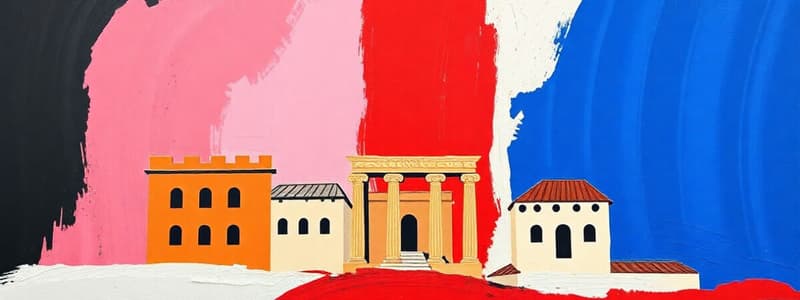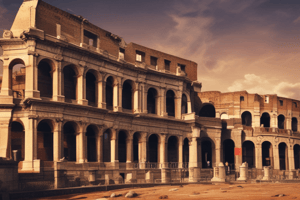Podcast
Questions and Answers
What was a primary method used to assess students' knowledge in public classes during the Roman period?
What was a primary method used to assess students' knowledge in public classes during the Roman period?
- Oral reports and presentations (correct)
- Standardized testing
- Written examinations
- Group projects
What type of education did teenagers aspiring for higher knowledge most likely pursue?
What type of education did teenagers aspiring for higher knowledge most likely pursue?
- Learning through family traditions only
- Traveling to Rome for practical training
- Traveling to Greece for lessons in philosophy and mathematics (correct)
- Studying at specialized trade schools
Which career was NOT considered an integral pillar of Roman culture?
Which career was NOT considered an integral pillar of Roman culture?
- Architect
- Senator
- General
- Trader (correct)
What significant contributions did Roman architects make to society?
What significant contributions did Roman architects make to society?
In the context of the Roman Republic, what role did generals primarily fulfill?
In the context of the Roman Republic, what role did generals primarily fulfill?
What unique property of pozzolana contributed to its use in Roman concrete?
What unique property of pozzolana contributed to its use in Roman concrete?
At what age did boys in wealthy Roman families typically continue their education beyond basic lessons?
At what age did boys in wealthy Roman families typically continue their education beyond basic lessons?
Which ancient civilization had a significant influence on the Roman educational system?
Which ancient civilization had a significant influence on the Roman educational system?
What was the primary construction material used for the foundations of aqueducts and bridges in ancient Rome?
What was the primary construction material used for the foundations of aqueducts and bridges in ancient Rome?
What was the fate of most noble girls' education after the age of twelve in ancient Rome?
What was the fate of most noble girls' education after the age of twelve in ancient Rome?
Which Roman structure known for its historical significance is fed by one of the aqueducts?
Which Roman structure known for its historical significance is fed by one of the aqueducts?
During what part of Roman education was there a strong emphasis on Greek literature?
During what part of Roman education was there a strong emphasis on Greek literature?
What system of education was prevalent in ancient Rome, especially among the wealthy?
What system of education was prevalent in ancient Rome, especially among the wealthy?
What was one of the essential materials used in the construction of Roman aqueducts that revolutionized their architecture?
What was one of the essential materials used in the construction of Roman aqueducts that revolutionized their architecture?
Which concept did Appius Claudius Caecus focus on when designing the aqueducts?
Which concept did Appius Claudius Caecus focus on when designing the aqueducts?
How were the children of freed slaves categorized in Roman society?
How were the children of freed slaves categorized in Roman society?
What types of professionals could be typically found in the central business district of Rome?
What types of professionals could be typically found in the central business district of Rome?
What was a primary function of Roman architects during the construction of urban infrastructure?
What was a primary function of Roman architects during the construction of urban infrastructure?
What type of markets did poor Romans and slave families typically utilize?
What type of markets did poor Romans and slave families typically utilize?
What innovation was crucial in enabling ancient Romans to build their aqueducts?
What innovation was crucial in enabling ancient Romans to build their aqueducts?
What was the primary purpose of the Forum in ancient Rome?
What was the primary purpose of the Forum in ancient Rome?
What was the ultimate fate of the majority of surviving slaves following the defeat of Spartacus?
What was the ultimate fate of the majority of surviving slaves following the defeat of Spartacus?
What was a significant consequence of Spartacus's rebellion for the Roman Senate?
What was a significant consequence of Spartacus's rebellion for the Roman Senate?
What led Spartacus and his army to initially consider attacking Rome during their campaign?
What led Spartacus and his army to initially consider attacking Rome during their campaign?
How did Spartacus ultimately meet his end during the conflict with Roman forces?
How did Spartacus ultimately meet his end during the conflict with Roman forces?
What was one of the long-term impacts of the gladiatorial games on Roman society?
What was one of the long-term impacts of the gladiatorial games on Roman society?
What was the primary purpose of the Colosseum in ancient Rome?
What was the primary purpose of the Colosseum in ancient Rome?
Which of the following statements about gladiatorial training is most accurate?
Which of the following statements about gladiatorial training is most accurate?
How did the presence of gladiatorial games impact Roman society?
How did the presence of gladiatorial games impact Roman society?
Which group of individuals was typically forced to become gladiators?
Which group of individuals was typically forced to become gladiators?
What role did female gladiators, if they existed, primarily serve in the arena?
What role did female gladiators, if they existed, primarily serve in the arena?
What was one of the main motivations for prominent citizens to attend gladiatorial games?
What was one of the main motivations for prominent citizens to attend gladiatorial games?
What likely led to the popularity of gladiatorial contests in Rome?
What likely led to the popularity of gladiatorial contests in Rome?
Which event is associated with Spartacus in relation to gladiatorial entertainment?
Which event is associated with Spartacus in relation to gladiatorial entertainment?
What distinguished a murmillo gladiator from a thraex gladiator?
What distinguished a murmillo gladiator from a thraex gladiator?
What role did women gladiators play in the arenas before being banned?
What role did women gladiators play in the arenas before being banned?
What was a significant aspect of Spartacus's background before becoming a gladiator?
What was a significant aspect of Spartacus's background before becoming a gladiator?
What was one of the reasons gladiators maintained emotional distance from each other?
What was one of the reasons gladiators maintained emotional distance from each other?
Which type of gladiatorial combat was most favored by the audiences?
Which type of gladiatorial combat was most favored by the audiences?
What was the typical fate of gladiators in training according to the conditions they faced?
What was the typical fate of gladiators in training according to the conditions they faced?
What role did animal fights play in the context of gladiatorial games?
What role did animal fights play in the context of gladiatorial games?
What was a characteristic of the audience's reaction to gladiatorial games?
What was a characteristic of the audience's reaction to gladiatorial games?
Flashcards
Public education
Public education
Public classes lacked formal structure, relying on oral reports and presentations to assess student understanding.
Home schooling
Home schooling
Families often used tutors or fathers' direct instruction to educate children. Fathers saw education as a way to gain respect and acclaim.
Higher education destinations
Higher education destinations
Teenagers seeking higher education frequently travelled to Greece for lessons in philosophy, mathematics, and astronomy.
Roman education outcomes
Roman education outcomes
Signup and view all the flashcards
Roman contributions
Roman contributions
Signup and view all the flashcards
Roman Freedmen
Roman Freedmen
Signup and view all the flashcards
Roman Forum Market
Roman Forum Market
Signup and view all the flashcards
Roman Aqueduct
Roman Aqueduct
Signup and view all the flashcards
Aqua Appia
Aqua Appia
Signup and view all the flashcards
Roman Concrete
Roman Concrete
Signup and view all the flashcards
Roman Urban Planning
Roman Urban Planning
Signup and view all the flashcards
Roman Sewage System
Roman Sewage System
Signup and view all the flashcards
Appius Claudius Caecus
Appius Claudius Caecus
Signup and view all the flashcards
Roman Concrete Durability
Roman Concrete Durability
Signup and view all the flashcards
Pozzolana's Function
Pozzolana's Function
Signup and view all the flashcards
Roman Education
Roman Education
Signup and view all the flashcards
Roman Girls' Education
Roman Girls' Education
Signup and view all the flashcards
Influence of Greek Culture
Influence of Greek Culture
Signup and view all the flashcards
Homer and Hesiod
Homer and Hesiod
Signup and view all the flashcards
Roman Education Funding
Roman Education Funding
Signup and view all the flashcards
Murmillo
Murmillo
Signup and view all the flashcards
Thraex
Thraex
Signup and view all the flashcards
Eques
Eques
Signup and view all the flashcards
Essedarius
Essedarius
Signup and view all the flashcards
Gladiator Variety
Gladiator Variety
Signup and view all the flashcards
Women Gladiators
Women Gladiators
Signup and view all the flashcards
Gladiator Oath
Gladiator Oath
Signup and view all the flashcards
Gladiator Bonds
Gladiator Bonds
Signup and view all the flashcards
Spartacus' Goal
Spartacus' Goal
Signup and view all the flashcards
Why Rome Feared Spartacus
Why Rome Feared Spartacus
Signup and view all the flashcards
Crassus's Role
Crassus's Role
Signup and view all the flashcards
Spartacus's Last Stand
Spartacus's Last Stand
Signup and view all the flashcards
Brutal Aftermath
Brutal Aftermath
Signup and view all the flashcards
Gladiator Games
Gladiator Games
Signup and view all the flashcards
Colosseum
Colosseum
Signup and view all the flashcards
Gladiators' Origins
Gladiators' Origins
Signup and view all the flashcards
Gladiator Classes
Gladiator Classes
Signup and view all the flashcards
Roman Entertainment
Roman Entertainment
Signup and view all the flashcards
Roman Psyche
Roman Psyche
Signup and view all the flashcards
The Colosseum's Purpose
The Colosseum's Purpose
Signup and view all the flashcards
Colosseum's Diverse Uses
Colosseum's Diverse Uses
Signup and view all the flashcards
Study Notes
Roman Republic Defining Features
- Romans believed their culture and civilization was superior
- Concept of self-rule was central to their image
- Their actions were viewed as egotistical, Rome-centric
Roman Provincial Dictatorship
- Romans established a form of dictatorship in conquered territories
- Roman citizens imposed their rule through governors and magistrates
Roman Knowledge and Correctness
- Romans believed in the innate correctness of their beliefs
- This belief persists in Western culture to this day
Roman Cultural Enlightenment
- Romans considered themselves to be the peak of cultural development
- Rome's culture was exemplified by the city's size
Roman Population in the Period
- Rome housed approximately one million people in the period described
Roman Society Structure
- Roman society was rigidly patriarchal
- Roman men held significant legal control over their wives, daughters, and sons
Roman Slavery
- Slavery was a widespread and significant part of Roman life
- Not based on race or ethnicity; based on misfortune of being captured
- Slaves performed a wide range of jobs and roles, vital to Roman economy, infrastructure and daily life
Roman Slave Identification
- Slaves were often indistinguishable from free citizens.
- They wore similar clothing, potentially contributing to unrest
- Attempts to differentiate slaves via uniform were rejected by the Senate in the belief that a slave revolt was possible.
Roman City Life
- Roman daily life focused on the Forum and central business district
- Citizens engaged in trading for various goods and services
- The common citizen likely patronized marketplaces.
Roman Education Structure
- Education was commonly available for wealthy children
- Basic education included numbers and letters
- Rich families provided education, boys were educated in Greek, Latin, public speaking, literature
- Girls, often married before 12, received less or possibly no further education
Roman Education for All Children's
- Education was not compulsory or funded by state, rather a part of rich families' social identity
- Education for poorer children was less structured and less common
- Oral exams, questions-and-answers, and presentations were common ways to test knowledge
Roman Government and Jobs
- Roman citizens could occupy some government positions and vote despite inability to run for public office
Studying That Suits You
Use AI to generate personalized quizzes and flashcards to suit your learning preferences.




